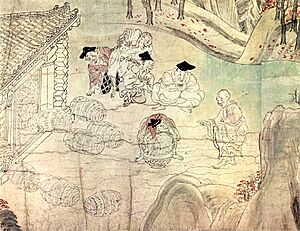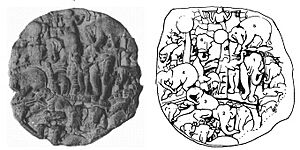Narrative art facts for kids
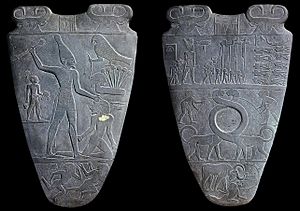
Narrative art is art that tells a story. It can show one moment from a story or a series of events happening over time. Some of the very first human artworks show that people used pictures to tell stories. Even though all narrative art shares some features, different cultures have found unique ways to show stories through pictures.
Long ago, before many people could read, most narrative art showed stories all at once, without much clear order. Once reading and writing became more common, artists started to organize pictures in rows, like lines on a page. This helped show the story's direction. This way of linking scenes led to modern storytelling methods, like newspapers, comic strips, and comic books.
In traditional Western art since the Renaissance, a type of painting called history painting often includes many narrative scenes.
Contents
History of Storytelling Art
Even though it takes clever ways to make a story clear, narrative art appeared very early in the history of art.
Ancient Art and Early Stories
Some carvings from the European Bronze Age in the Rock art of the Iberian Mediterranean Basin show simple stories of hunting or battles. They sometimes even show the paths of hunters or animals, like a modern map! One of the oldest pieces of Ancient Egyptian art is the Narmer Palette. This carved stone in the Louvre Museum shows King Narmer winning a battle around 3100 BC, told in several scenes.
Assyrian Empire's Grand Narratives
Narrative art was used a lot in the Neo-Assyrian Empire. The walls of the main Assyrian royal palaces were covered with stone carvings. These carvings showed the king's activities, like hunting, fighting battles, and performing rituals. Sometimes, scenes were also painted on walls or made with colorful glazed bricks.
Bronze bands that decorated the doors of Assyrian temples and palaces also showed the king's stories. The most famous are the "Balawat Gates," made for King Shalmaneser III's palace.
Religious Stories in Art
The lives of Jesus and Buddha, who started new religions, gave artists many new stories to tell. Older religions also provided subjects, like the Labours of Hercules. Trajan's Column in Rome is an amazing example of Roman narrative art.
In Christian art, the Life of Christ in art and Life of the Virgin were very common subjects. These showed events from the main church holidays. Stories about saints also provided many other ideas for artists.
Illustrated Books
Book illustrations have been around since ancient times in many cultures, and they often tell stories. It seems there were some very fancy illustrated books in Western Late Antiquity, probably owned by rich collectors. These included both classic stories and biblical texts. An old Bible piece called the Quedlinburg Itala fragment might have had two to four pictures for every page of text!
Types of Narrative Art
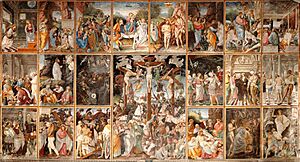
Stories happen in a place and unfold over time. In narrative art, the artist chooses how to show the story, how to represent the space, and how to shape time within the artwork. Narrative art can be put into different groups, also called modes or styles. An artwork isn't limited to just one type of narrative. A whole artwork might have one type, while parts of it show other types.
Here are some common types:
Simultaneous Narrative
A simultaneous narrative is a type of story art that might not look very organized at first glance, especially if you don't know its purpose. It can focus on shapes or abstract designs, or how items are placed in the artwork. Simultaneous narratives often use repeating patterns and focus on pairs or opposites.
Monoscenic Narrative
A monoscenic narrative shows a single scene. The characters do not repeat, and only one main action is happening. This scene is usually easy to recognize within the story and is very important.
Most art that isn't usually thought of as narrative could fit this type. Narrative art tells a story, either a moment in a story or a series of events. This means a lot of art can be called narrative art. However, landscapes and portraits usually don't fit, unless the artist meant for them to tell a story.
Achilles Kills Penthesilea (Amphora) by Exekias
Exekias was an ancient Greek vase-painter. Many of his vases showed scenes from Greek myths. He was known for showing the most important parts of a story in one simple scene. The large vase (amphora) showing Achilles killing Penthesilea is a good example.
This monoscenic narrative on the amphora shows a very important part of the Trojan War story. It's the moment when Achilles and Penthesilea fall in love. In the heat of battle, Achilles fights Penthesilea. With a deadly blow, he knocks her helmet back. When their eyes meet, they are said to fall in love. But Achilles cannot control his anger in battle, and this tragic moment leads to many problems for him later, even his downfall.
British Art Tradition
A style of narrative art began with William Hogarth, an English painter. His single-scene pictures of key moments in a story were later used by other British painters in the 1800s. In Victorian times, this style was called "subject painting" or "anecdotic" painting.
Continuous Narrative
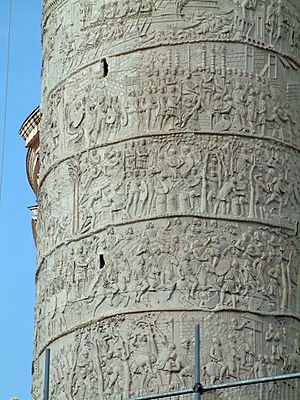
A continuous narrative shows many scenes from a story within one single picture. Multiple actions and scenes are shown in one visual space without any dividers. The order of events is shown by using the same main character or characters again and again. It highlights how the repeating characters move and change, which shows changes in the scene or part of the story.
Column of Trajan
The Column of Trajan shows one big event: the Dacian Wars. This continuous narrative can be broken into many smaller events. These events flow from one scene to another without any physical lines separating them. When you stand in front of the column, the story seems to go from right to left, then left to right, which is common in continuous narratives.
The story becomes harder to read as the column gets taller. Experts think the column was meant to be read while walking up a spiral staircase around it. In that case, the story would continue in a steady, flowing way.
Bayeux Tapestry

The 'Bayeux Tapestry' (it's actually an embroidery, not a tapestry) tells the story of the Norman invasion of England in 1066. The main idea of the Bayeux Tapestry is betrayal and trickery. The story shows a Norman point of view of the events of the conquest. Even though the tapestry seems to be framed by horizontal lines, it is still a continuous narrative. These lines are needed to fit the story into a certain area. If you were to cut and place the scenes next to each other, it would be one long, continuous story. A continuous narrative has no breaks between scenes and actions.
Synoptic Narrative
A synoptic narrative shows a single scene where a character or characters are shown many times within one picture. This is to show that multiple actions are happening. This makes the order of events in the story unclear. Synoptic narratives usually give visual clues to show the order, but they can still be hard to understand if you don't know the story.
Chaddanta Jataja, Amaravati
One example of a synoptic narrative is found in a round carving from the stupa at Amaravati. Like many synoptic narratives, it can be hard to understand. The carving is meant to tell the story of Buddha's past life as the elephant Chaddanta. The center of the carving has only decorations, which is a clue that the carving should be read in a circle. Besides that small clue, the artist gives very few hints about the order of events.
The carving can be divided into 7 parts:
- 1 - Chaddanta gives his main queen a lotus flower.
- 2 - His junior queen feels upset.
- 3 – The junior queen leaves to be on her own.
- 4 – She is dying, hoping for revenge.
- 5 – A hunter aims an arrow at Chaddanta.
- 6 – The hunter saws off Chaddanta's tusks.
- 7 - The hunter leaves with the tusks (at the very top center).
Panoramic Narrative
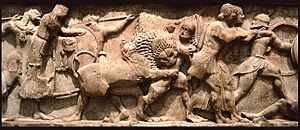
A panoramic narrative shows many scenes and actions without repeating the characters. The actions might be in a sequence or show things happening at the same time during an event.
Siphnian Treasury North Frieze
The Siphnian Treasury at Delphi has four marble carvings (friezes), one for each main direction. These four friezes show panoramic narratives through their carvings. The north frieze shows a battle between the Olympic gods and the giants. On the far left, two giants attack Zeus in his chariot, but Zeus is no longer visible due to damage. Hera is shown finishing off a giant to the right of Zeus, with Athena behind her (further right) fighting two giants. To the right of Athena is her brother Ares, who is fighting two other giants, with one already dead at his feet. Many stories are happening at once, with each fighter in different scenes. The dead giant at Ares' feet was defeated by Athena, but Ares is shown moving forward in the story by stepping over the body.
Progressive Narrative

A progressive narrative shows a single scene where characters do not repeat. However, many actions are happening to show time passing in the story. A progressive narrative is not meant to be seen as a group of events happening at the same time. Instead, it's a sequence that depends on its location. Actions shown by characters in these stories combine present and future actions into one picture.
Sequential Narrative
A sequential narrative is very much like a continuous narrative, but with one big difference. A sequential narrative uses frames to show time passing. Each scene and action is shown within its own frame, like a single unit. Each frame is a specific scene at a specific moment. A sequential narrative is the type of story often used in comics.
See also


